Laboratory Investigation of the Water Damage Resistance of Tuff Asphalt Mixture Modified with Additives
Abstract
1. Introduction
2. Raw Materials
2.1. Asphalt
2.2. Additives
2.3. Mineral Materials
2.4. Mix Design of Asphalt Mixtures
3. Test Methods
3.1. Adhesion Test
3.2. Water Stability and Aging Tests
- (1)
- Key indicator of water stability
- (2)
- Aging test
- 1)
- After conducting the immersion Marshall test and freeze–thaw splitting test, the aging effect of the asphalt mixture was considered to evaluate the durability of the mixture for water damage resistance. In this study, a long-term aging test was conducted in two steps [27].
- 2)
- After tuff mixtures with different additive schemes were mixed, the mixtures were introduced into the tray and tiled. Then, they were placed in an oven at 135 °C for 4 h to implement short-term aging, as shown in Figure 3a.
3.3. High- and Low-Temperature Performance Tests
- (1)
- Immersion rutting test
- (2)
- Beam bending test
4. Results and Discussion
4.1. Effect of Different Additives on Adhesion Property
4.2. Effect of Different Additives on Water Stability
4.3. Effect of Aging on Water Stability
4.4. High- and Low-Temperature Performance
- (1)
- High-temperature performance
- (2)
- Low-temperature performance
5. Conclusions
- (1)
- The adhesion property of tuff aggregates under water conditions was poor, and the improvement effect after implementing different additive schemes exhibited differences. The modification effect for adding 1% cement or 0.3% liquid anti-stripping agent was inevident, but the effect of adding higher contents was better. That is, the adhesion grade can reach 4 or 5, and it was close to that of limestone aggregate.
- (2)
- The water stability indexes of the tuff mixture control sample were the smallest among all the mixture samples, but the residual stability and freeze–thaw splitting ratio of the tuff mixture with different additives were improved. The modification effect of the cement scheme was better than that of the anti-stripping agent scheme, and its results were close to those of the limestone mixture.
- (3)
- Compared with the water stability indexes of the tuff mixture control sample after aging, residual stability was improved after adding a liquid anti-stripping agent, but the improvement effect was not as significant as that of adding cement. The freeze–thaw splitting strength ratio of the tuff mixture with liquid anti-spalling agent was not good, while the index of the tuff mixture with cement was more significant and closer to the result of the limestone mixture.
- (4)
- The high-temperature performance of the tuff mixture after adding cement was improved and close to that of the limestone mixture. The dynamic stability index of the tuff mixture was similar after adding 2% or 3% cement content. Meanwhile, the low-temperature performance of the tuff mixture was also improved after adding cement. However, the results of adding 2% cement content were closer to that of the limestone mixture, and thus, the modification effect with 2% cement content was better than that with 3% cement content.
Author Contributions
Funding
Institutional Review Board Statement
Informed Consent Statement
Data Availability Statement
Conflicts of Interest
References
- Tan, Y.; Li, X.; Zhou, X. Interactions of granite and asphalt based on the rheological characteristics. J. Mater. Civ. Eng. 2010, 22, 820–825. [Google Scholar]
- Zhao, X.; Sheng, Y.; Lv, H.; Jia, H.; Liu, Q.; Ji, X.; Xiong, R.; Meng, J. Laboratory investigation on road performances of asphalt mixtures using steel slag and granite as aggregate. Constr. Build. Mater. 2022, 315, 125655. [Google Scholar] [CrossRef]
- Yılmaz, M.; Tugrul, A.; Karasahin, M.; Boz, I. Assessing the stripping properties of granite aggregates in bituminous mixtures. Bull. Eng. Geol. Environ. 2015, 74, 673–682. [Google Scholar] [CrossRef]
- Kan, A.; Gul, R. Properties of volcanic tuff sands as a new material for masonry mortar. Int. J. Nat. Eng. Sci. 2008, 2, 69–74. [Google Scholar]
- Kılıç, A.; Atiş, C.D.; Yaşar, E.; Özcan, F. High-strength lightweight concrete made with scoria aggregate containing mineral admixtures. Cem. Concr. Res. 2009, 33, 1595–1599. [Google Scholar] [CrossRef]
- Al-Zboon Kamel, K.; Al-Zou, J. Effect of volcanic tuff on the characteristics of cement mortar. Eur. J. Environ. Civ. Eng. 2016, 20, 520–531. [Google Scholar] [CrossRef]
- Lin, M.; Yang, T.; Guan, H.X. Experimental research on high-temperature performance, low-temperature performance and water stability of tuff asphalt mixture. J. Highw. Transp. Res. Dev. 2016, 33, 1–6. [Google Scholar] [CrossRef]
- Li, M.; Zhai, M.; Ma, C.; Huang, C.; Yu, J.; Tang, F.; Qi, W.; Ye, C. Adhesion performance improvement research of a new interface modifier on acidic aggregate and asphalt. J. Wuhan Univ. Technol. (Transp. Sci. Eng.) 2018, 42, 48–51. [Google Scholar]
- Qian, X. The test analysis on cement to improve the adhesive of asphalt and acidic aggregate. J. Qinghai Norm. Univ. (Nat. Sci.) 2013, 29, 66–73. [Google Scholar]
- Zhang, Z.; Tang, Z. Effect of Self-melting Snow Agent on Performance of Asphalt Mixture. J. Chongqing Jiaotong Univ. (Nat. Sci.) 2020, 39, 92–99. [Google Scholar]
- Sun, Z.; Wang, S.; Li, G. Experimental study on the use of tuff as cushion layer material of pavement. J. China Foreign Highw. 2009, 29, 352–356. [Google Scholar]
- Goual, I.; Goual, M.S.; Taibi, S.; Abou-Bekr, N. Improving the properties of a natural tuff used in a Saharan road technique by adding calcareous sand. Eur. J. Environ. Civ. Eng. 2012, 16, 744–763. [Google Scholar] [CrossRef]
- Zhang, S.; Yu, X. Research on the applicability of expressway top surface course stone. Mod. Transp. Technol. 2007, 4, 1–3. [Google Scholar]
- Yuan, Y.Q.; Gao, D.Y.; Zhao, J.; Tang, J.Y.; Zhai, S.H. Experimental study on water stability of asphalt mixture. Adv. Mater. Res. 2011, 266, 135–138. [Google Scholar] [CrossRef]
- Ai, C.; Chen, J.; Liu, D. Research on measures to improving the water stability of granite asphalt mixture. Cent. South Highw. Eng. 2007, 32, 16–20. [Google Scholar]
- Huang, W.; Cui, T. Performance study on anti-rutting MPE modified asphalt mixture. J. Chongqing Jiaotong Univ. (Nat. Sci.) 2013, 32, 37–40. [Google Scholar]
- Ye, Y.; Hao, Y.; Zhuang, C.; Shu, S.; Lv, F. Evaluation on Improvement Effect of Different Anti-Stripping Agents on Pavement Performance of Granite–Asphalt Mixture. Materials 2022, 15, 915. [Google Scholar] [CrossRef]
- Birgisson, B.; Roque, R.; Page, G.C. Performance-based Fracture Criterion for Evaluation of Moisture Susceptibility in Hot-mix Asphalt. Transp. Res. Rec. 2004, 1891, 55–61. [Google Scholar] [CrossRef]
- Kong, L.; Xu, Y.; Cheng, Z. Comparative study on splitting strengths between WMA with limestone and WMA with granite. J. Highw. Transp. Res. Dev. 2015, 32, 31–35. [Google Scholar]
- Liu, H.; Qi, G.; Li, C. Study on improving grantie mixture road performance by anti-stripping agent TR-500S. Pet. Asph. 2020, 34, 1–6. [Google Scholar]
- Zhou, Q.; Song, Q.; Liu, L. Effect of different cement addition on the properties of granite asphalt concrete. Fly Ash Compr. Util. 2019, 5, 27–29+92. [Google Scholar]
- Standard JTG E20-2011; Standard Test Methods of Bitumen and Bituminous Mixtures for Highway Engineering. China Communications Press: Beijing, China, 2011; pp. 186–356.
- Standard GB175-2007; Common Portland Cement. Standards Press of China: Beijing, China, 2007; pp. 1–5.
- Standard JTG E42-2005; Test Methods of Aggregate for Highway Engineering. China Communications Press: Beijing, China, 2005; pp. 7–133.
- Lv, J.; Zhang, X. Prediction Models of Shear Parameters and Dynamic Creep Instability for Asphalt Mixture under Different High Temperatures. Polymers 2021, 13, 2542. [Google Scholar] [CrossRef] [PubMed]
- Wang, W.; Cheng, Y.; Zhou, P.; Tan, G.; Wang, H.; Liu, H. Performance evaluation of Styrene-Butadiene-Styrene-Modified stone mastic asphalt with basalt fiber using different compaction methods. Polymers 2019, 11, 1006. [Google Scholar] [CrossRef] [PubMed]
- Alnadish, A.M.; Aman, M.Y.; Katman, H.Y.B.; Ibrahim, M.R. Influence of the long-term oven aging on the performance of the reinforced asphalt mixtures. Coatings 2020, 10, 953. [Google Scholar] [CrossRef]
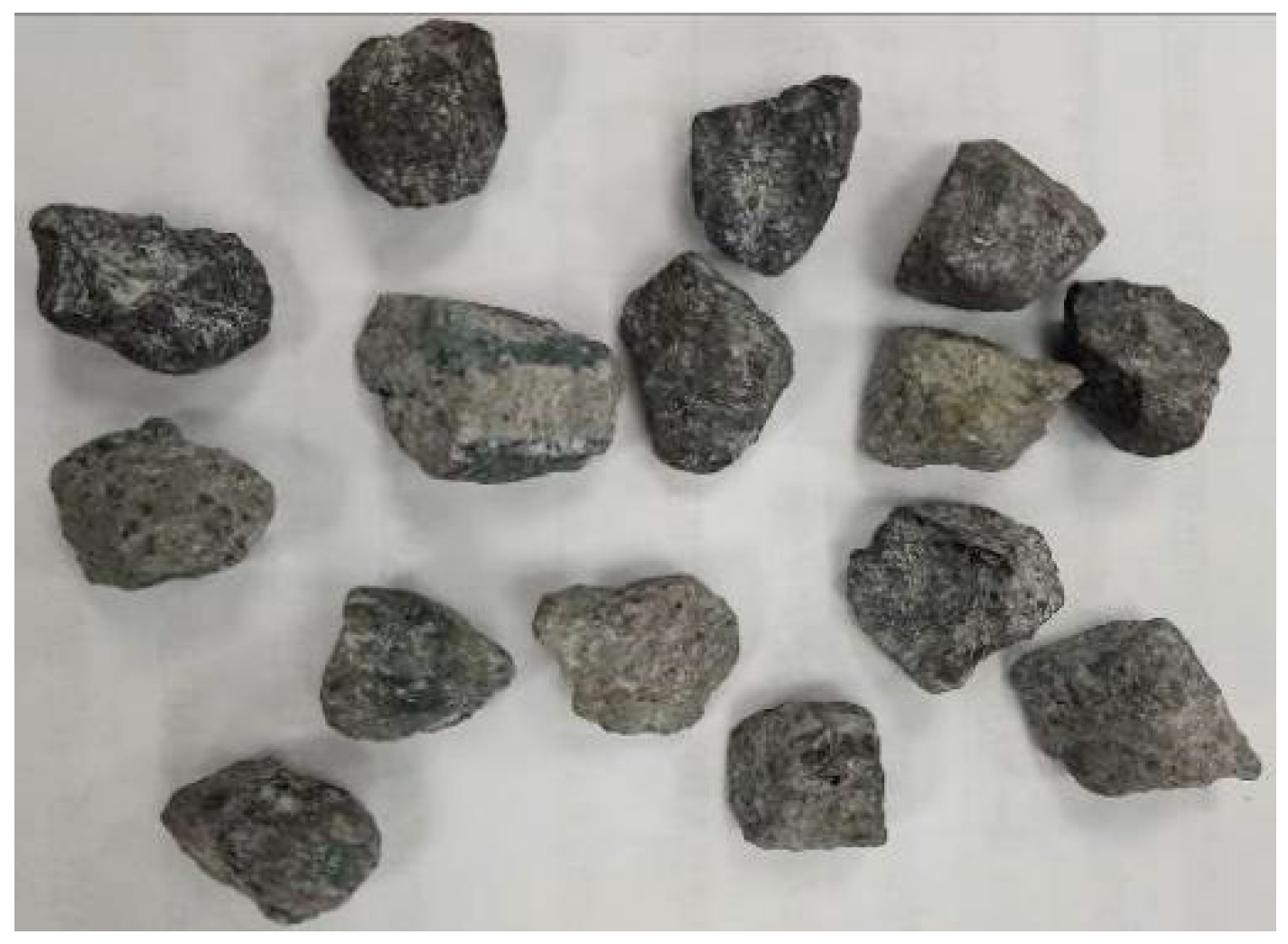
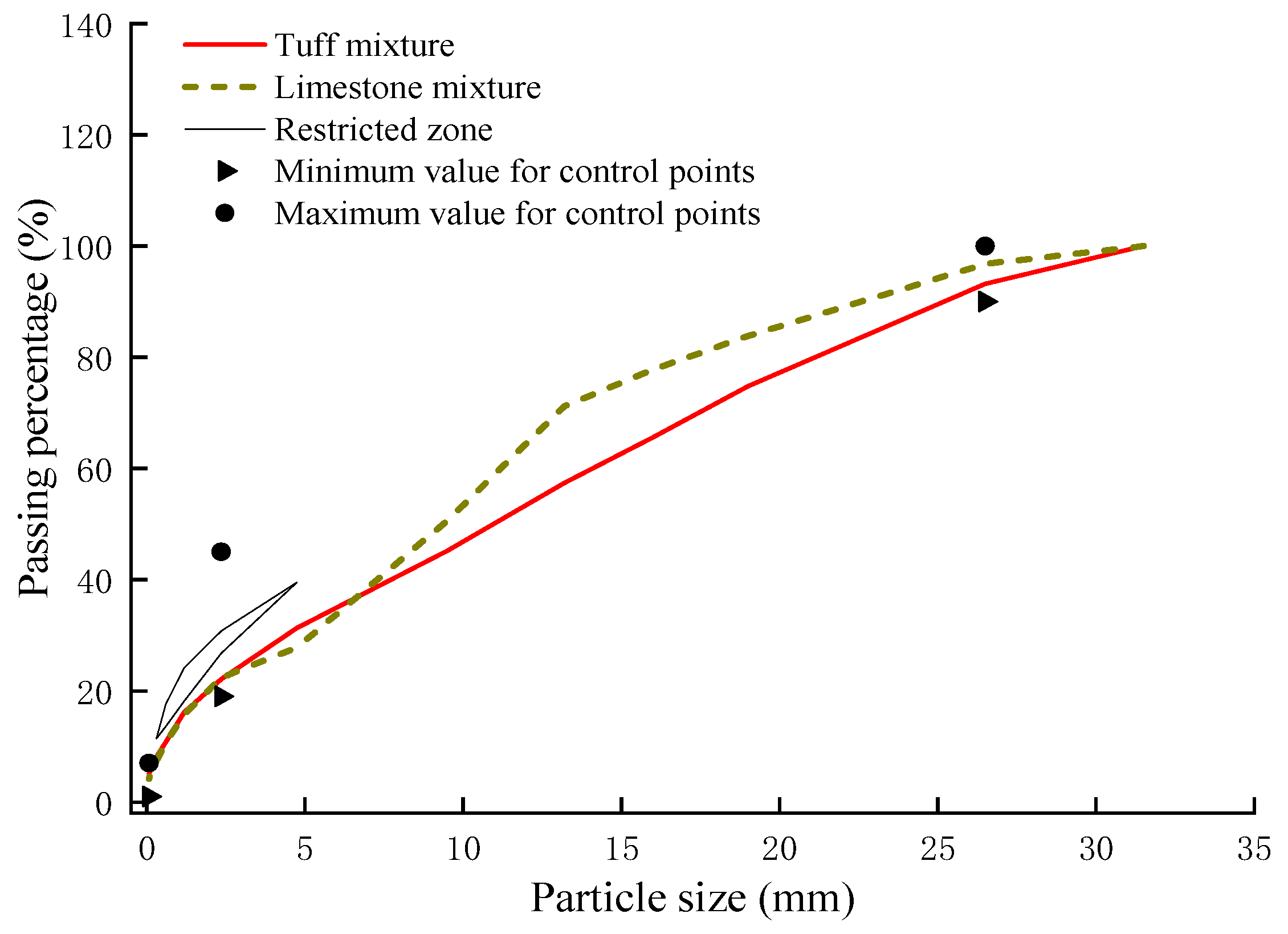
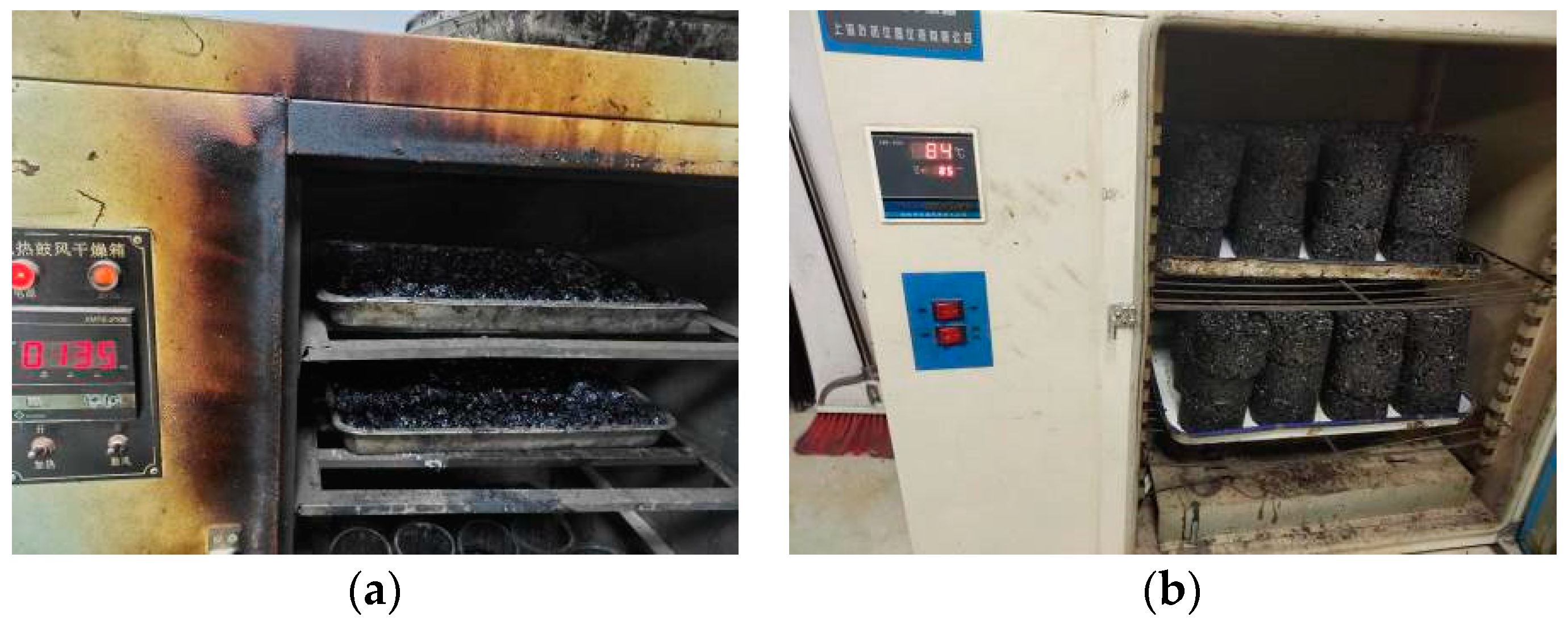

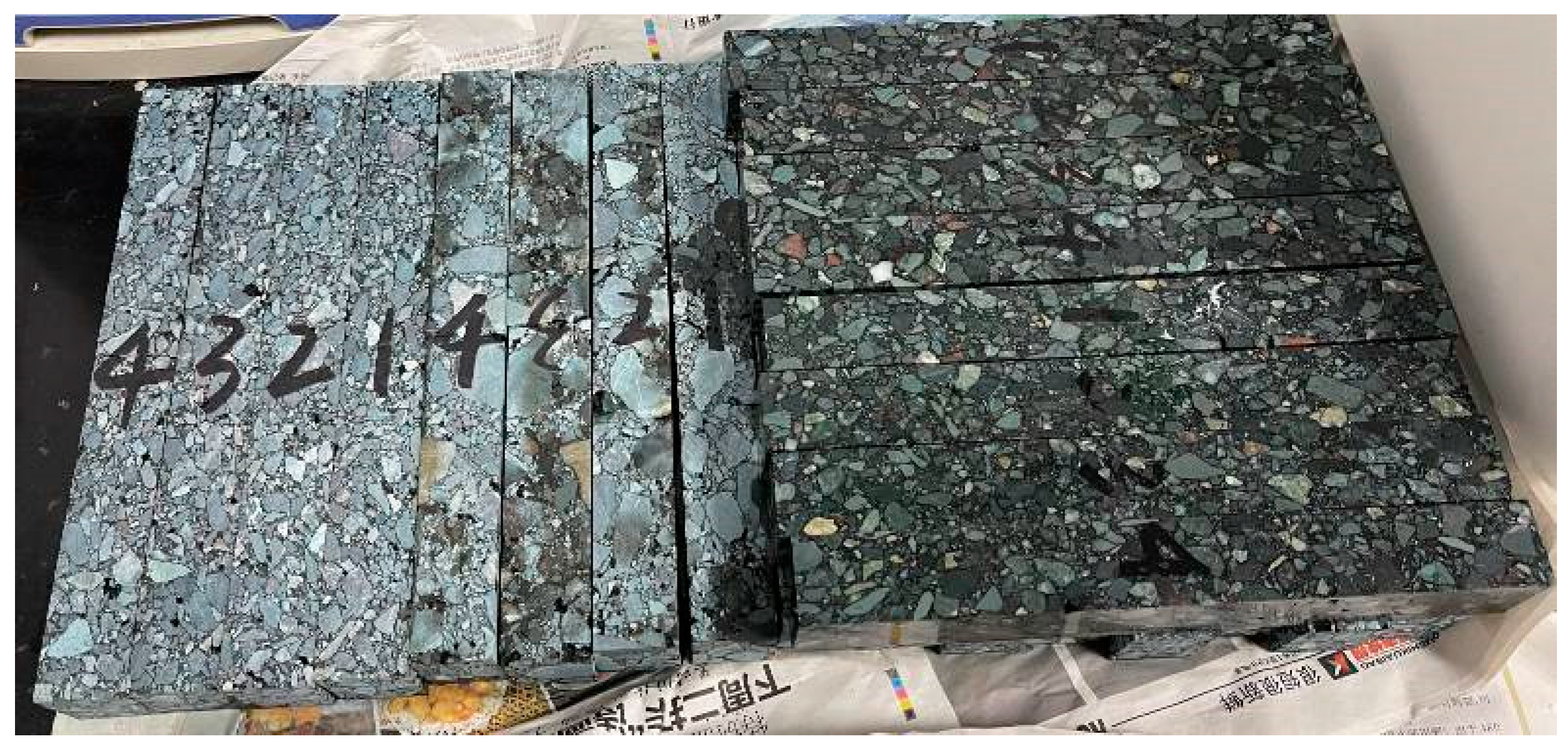
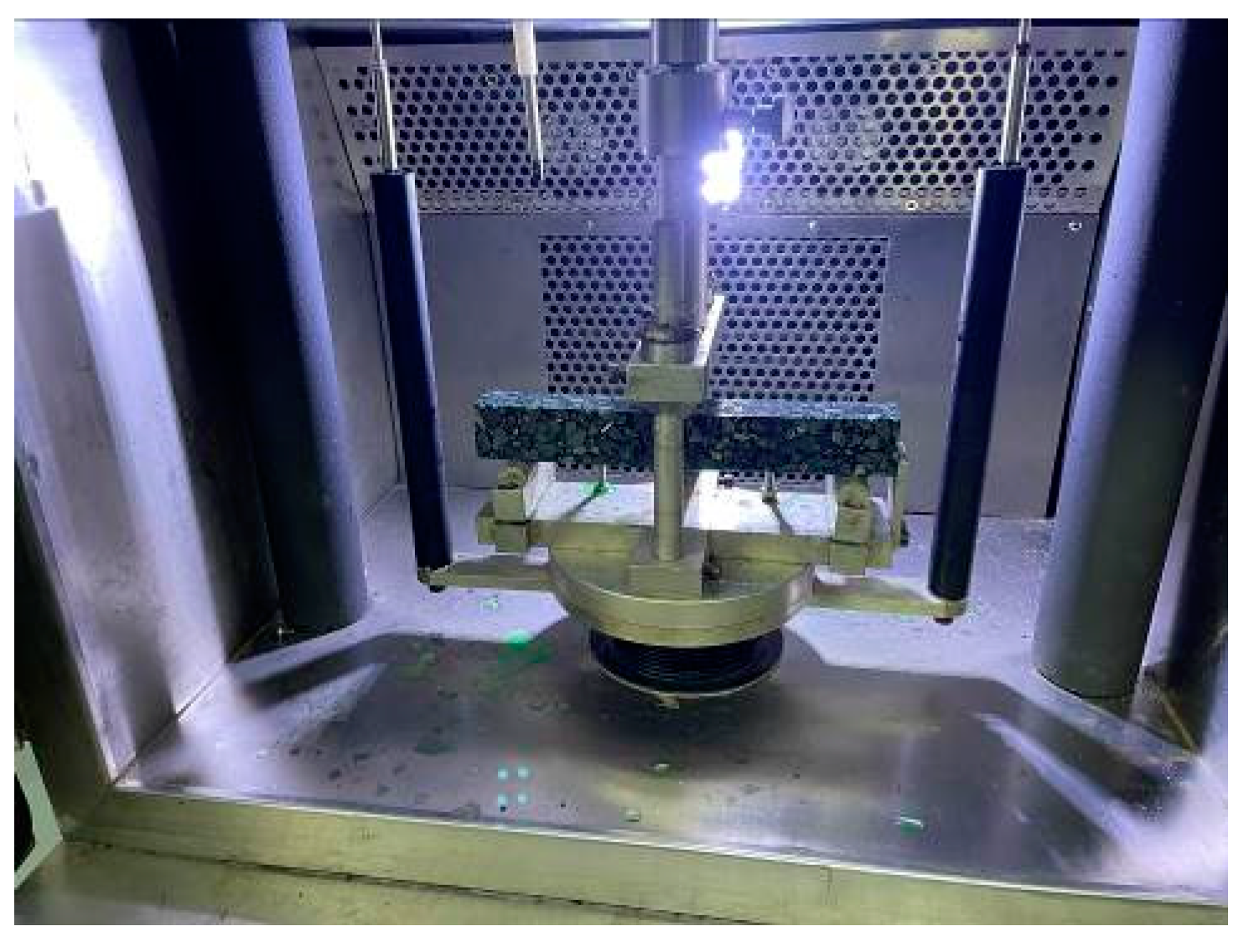
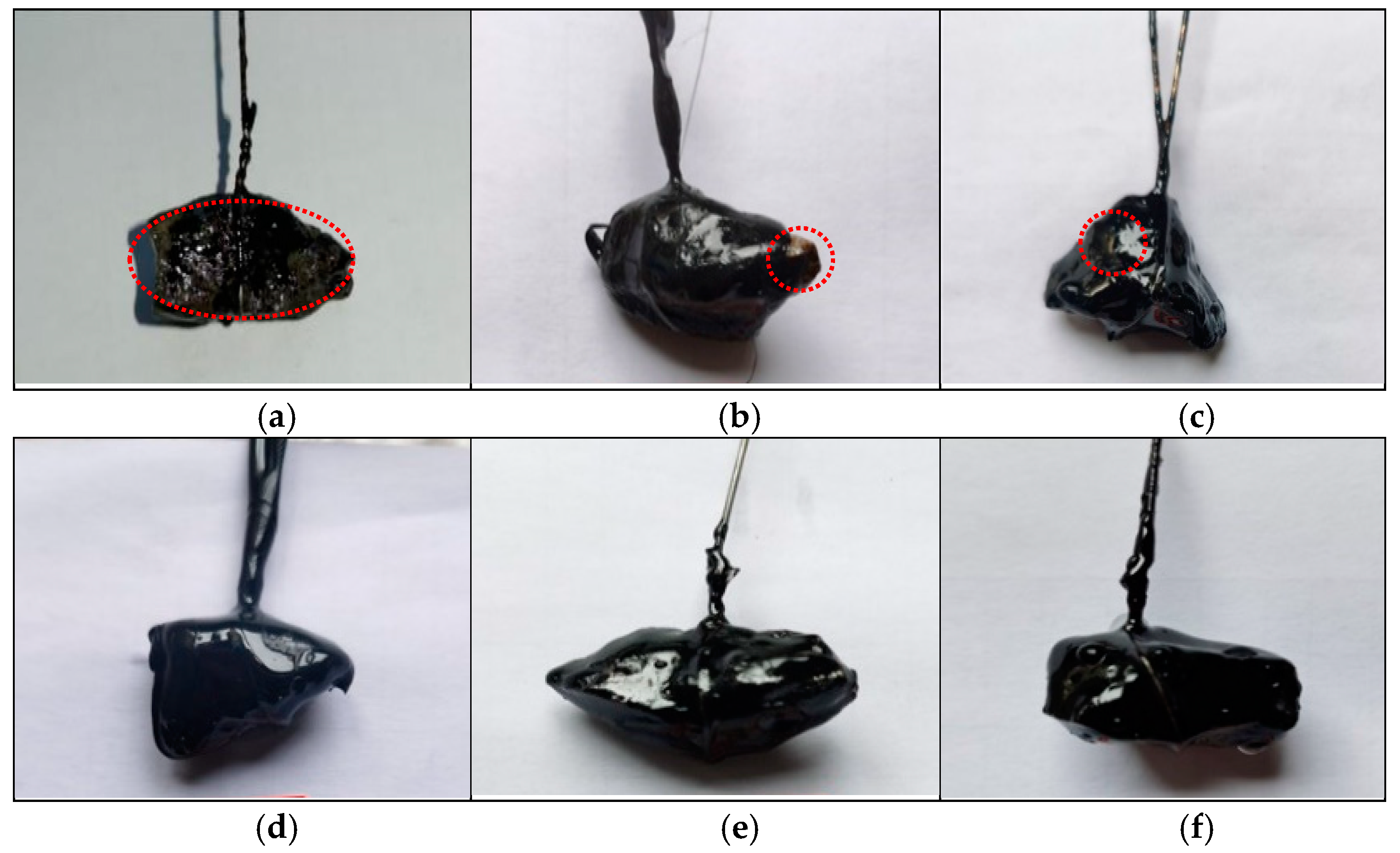
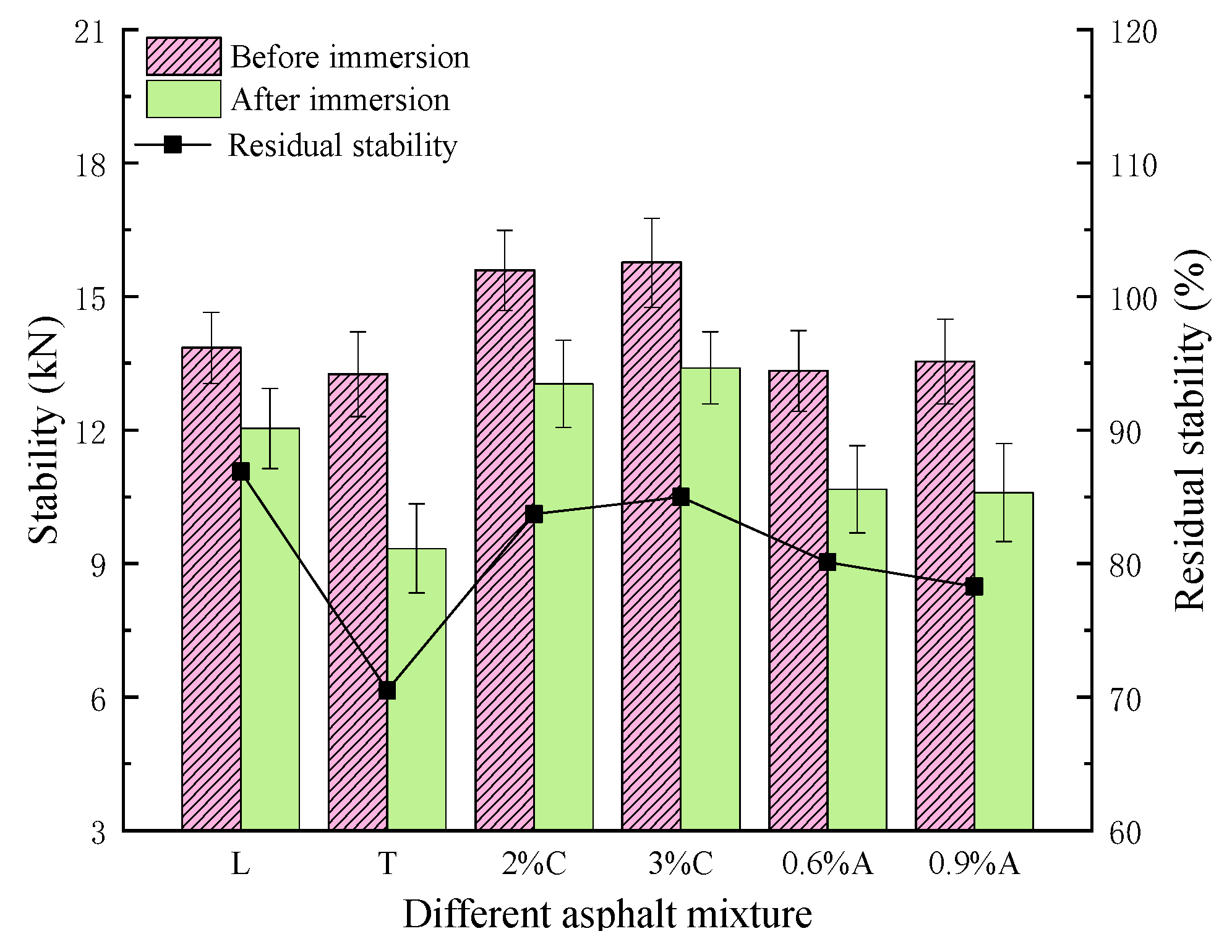
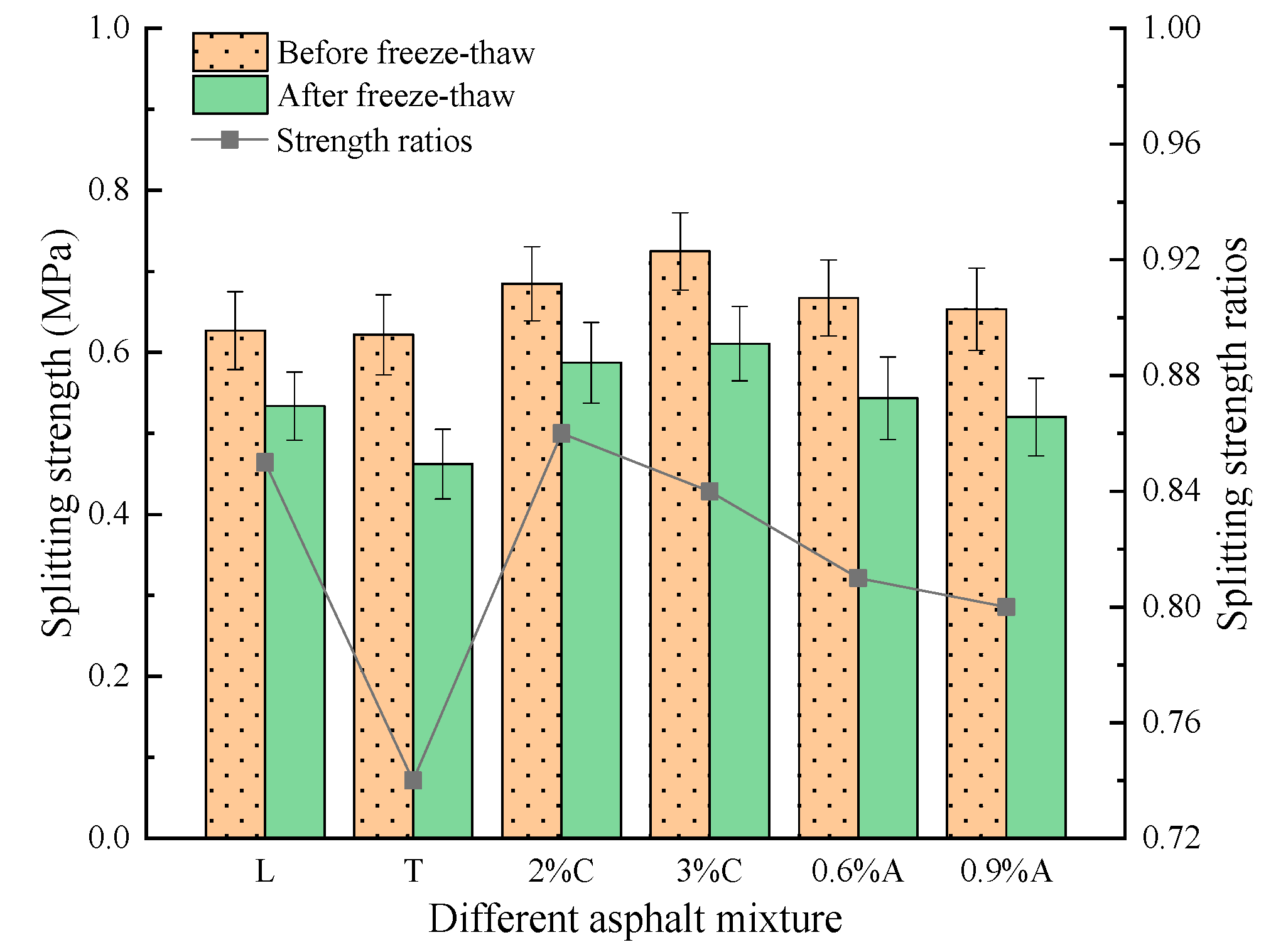
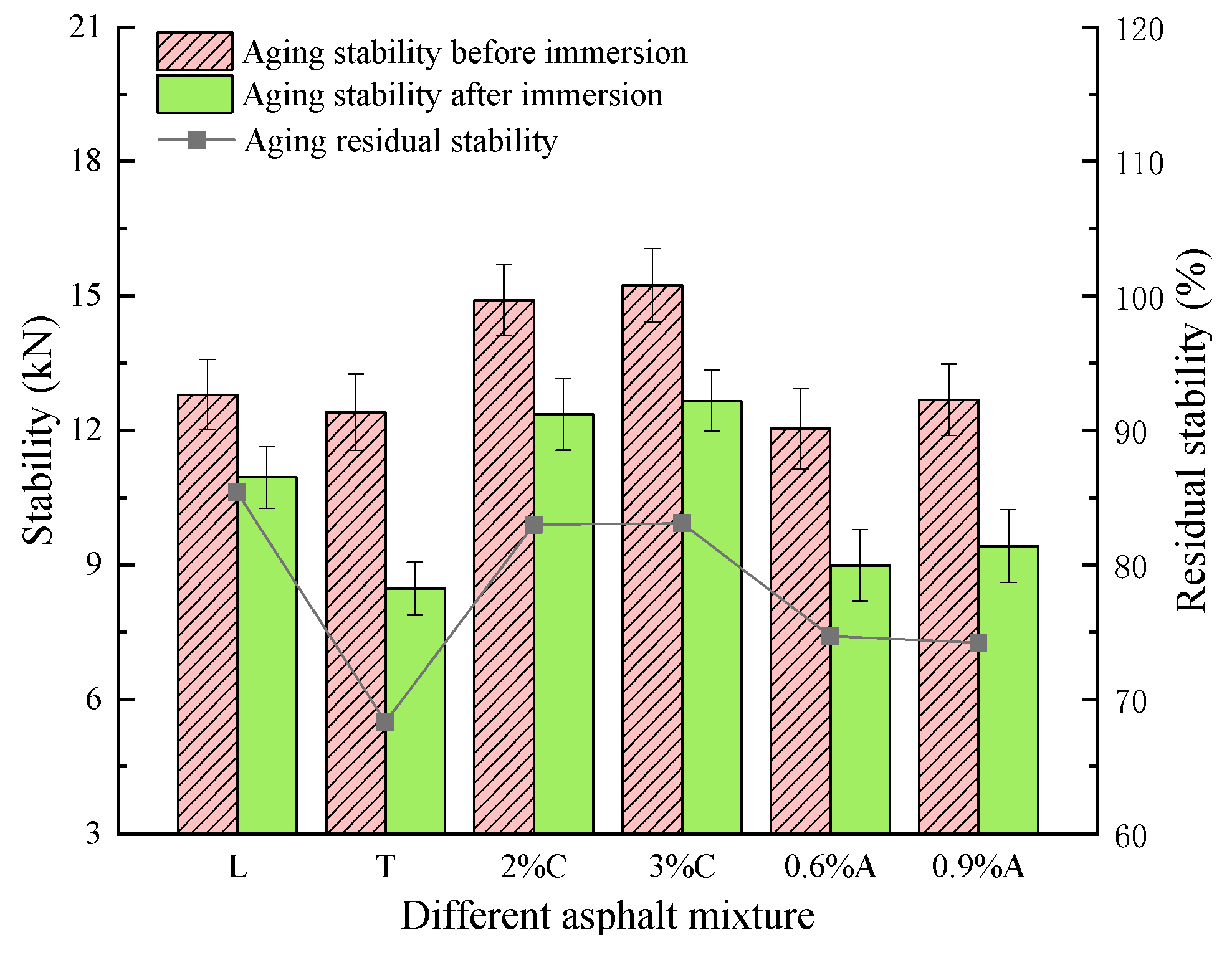
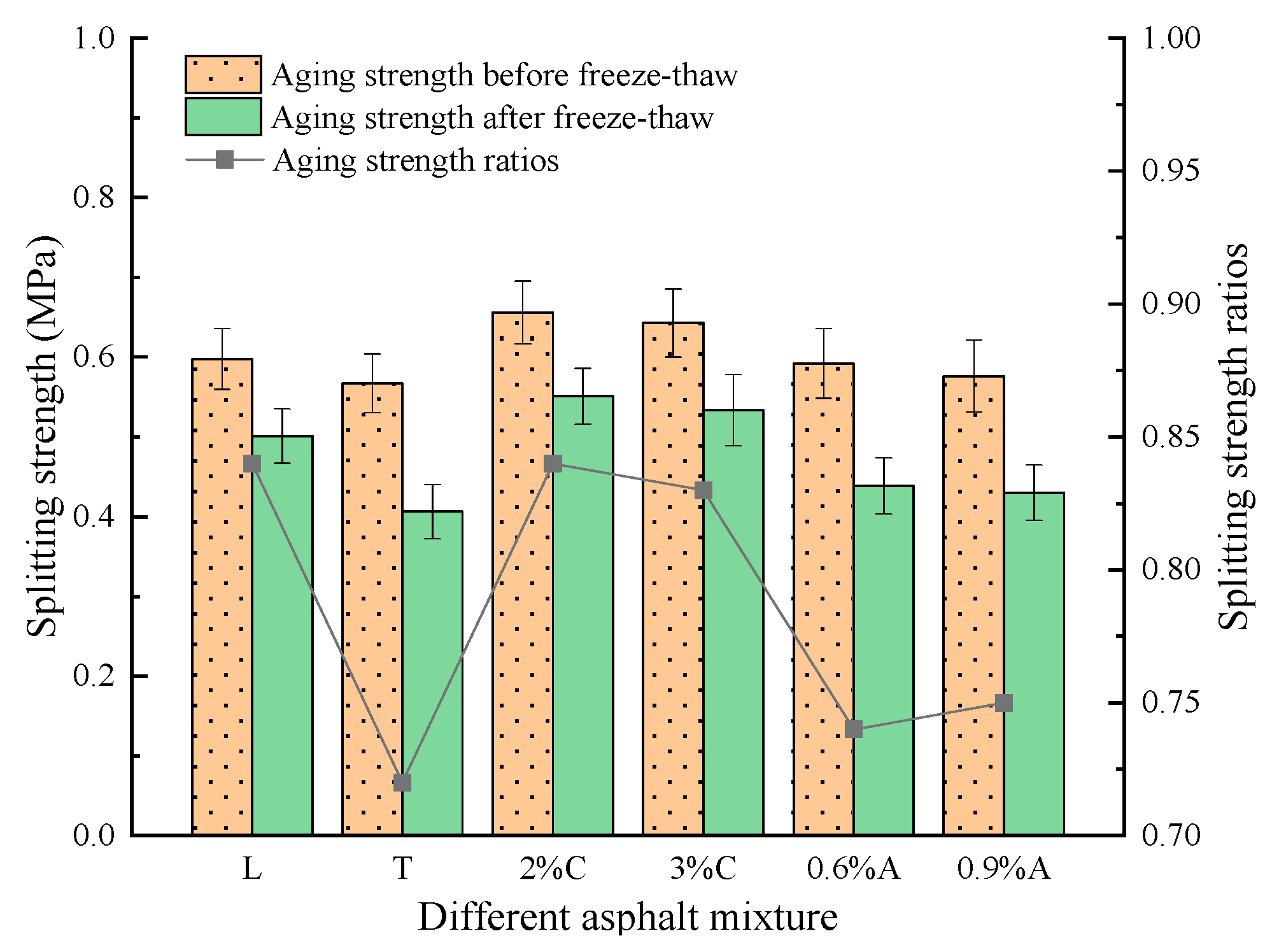
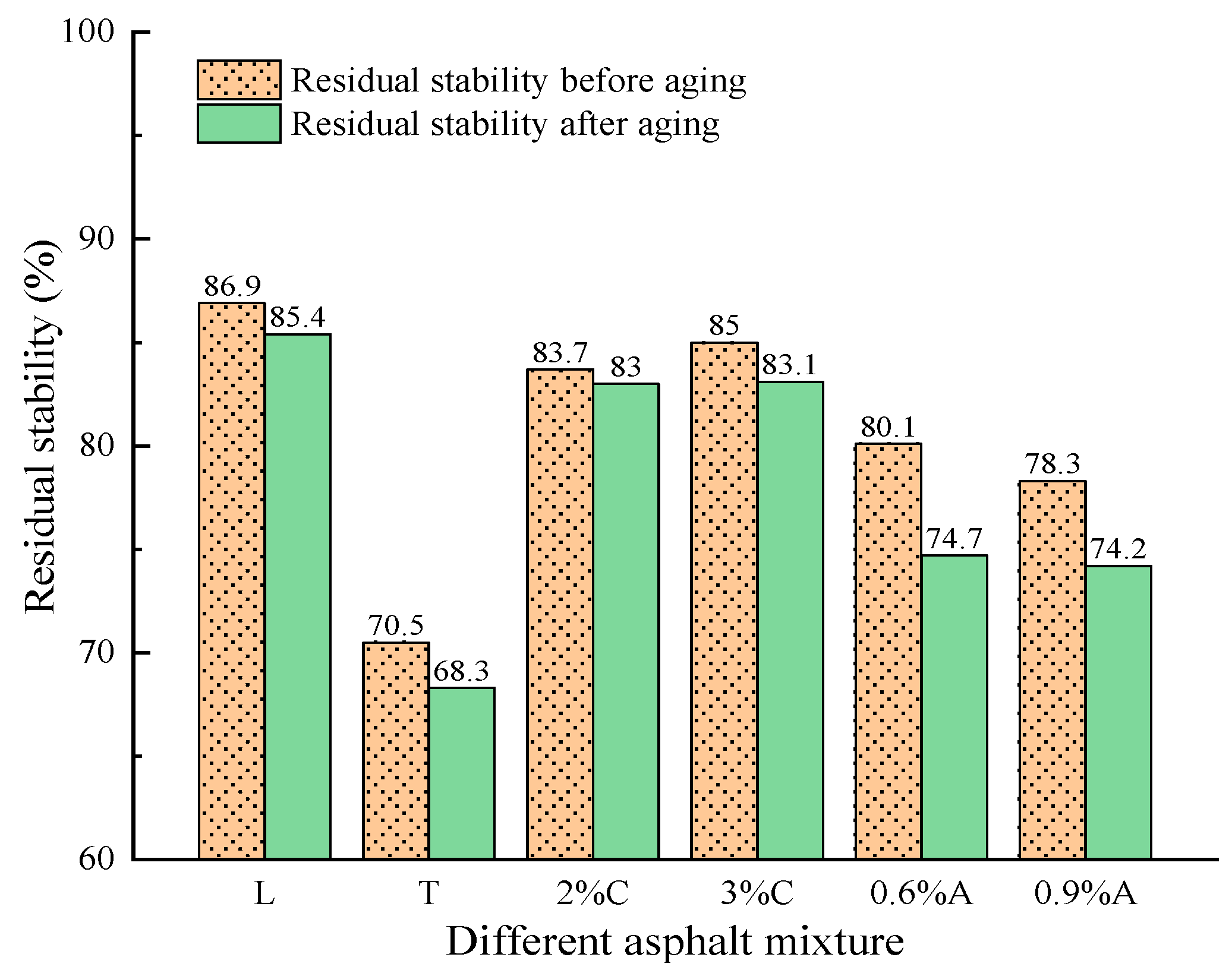

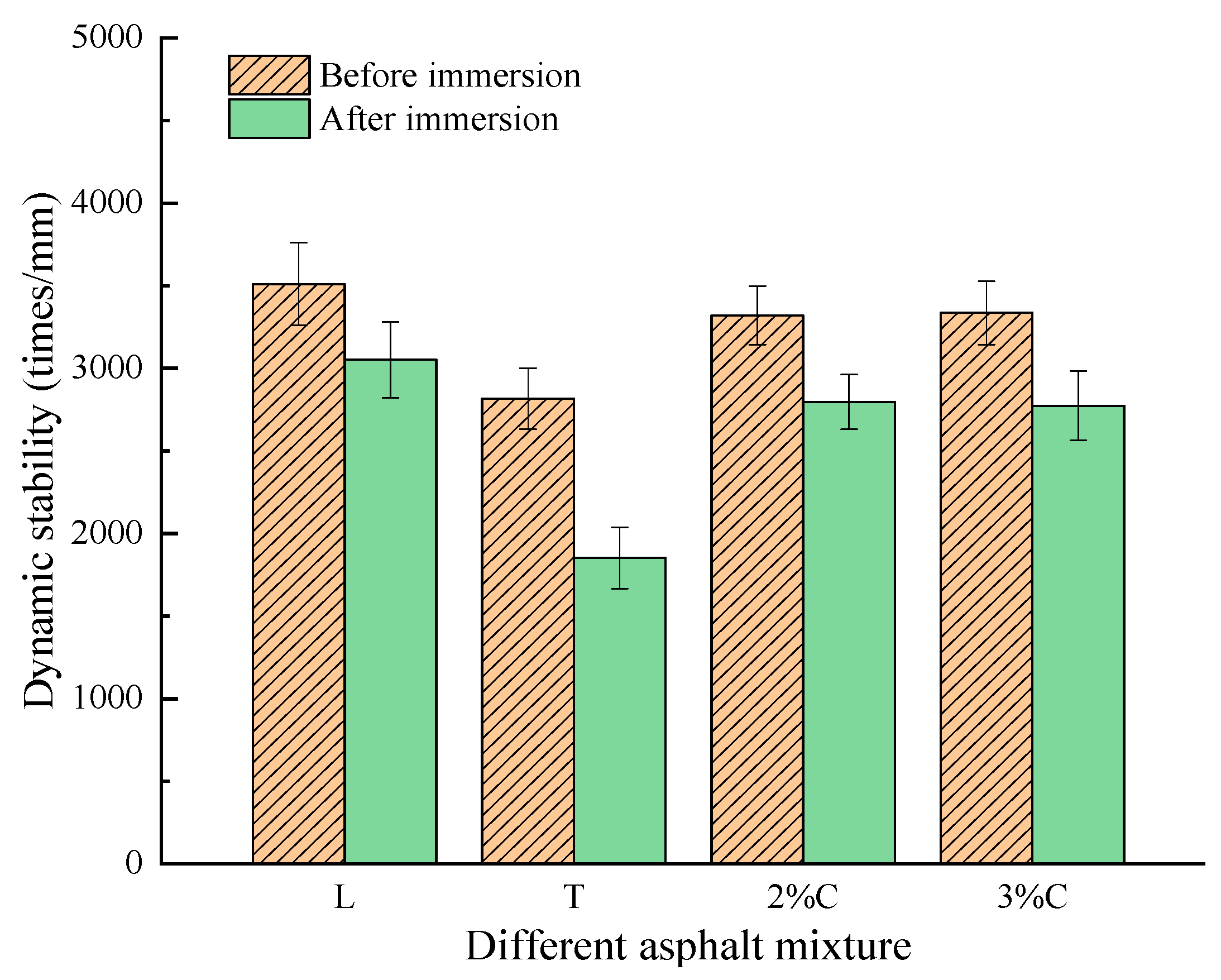
| Indexes | Technical Requirements | Test Results | Test Methods | |
|---|---|---|---|---|
| Penetration (25 °C, 100 g, 5 s), 0.1 mm | 60–80 | 68 | T0604 | |
| Penetration index (PI) | −1.5 to +1.0 | −0.6 | T0604 | |
| Ductility (5 cm/min, 10 °C), cm | ≥20 | 32 | T0605 | |
| Softening point (ring-and-ball method), °C | ≥46 | 47.5 | T0606 | |
| Dynamic viscosity (60 °C), Pa.s | ≥160 | 180 | T0620 | |
| Wax content (distillation method), % | 2.2 | 2.0 | T0615 | |
| Density (15 °C), g/cm3 | - | 1.01 | T0603 | |
| Solubility (trichloroethylene), % | ≥99.9 | 99.9 | T0607 | |
| TFOT after 163 °C and 5 h | Mass loss, % | ≤0.8 | 0.6 | T0609 |
| Penetration ratio after heating, % | ≥61 | 65 | T0610 | |
| Ductility (10 °C), cm | ≥6 | 8 | ||
| Indexes | Results | Technical Requirements |
|---|---|---|
| Specific area, m2/kg | 344 | ≥300 |
| Soundness, mm | 1.0 | ≤5 |
| Flexural strength at 28 days, MPa | 8.7 | ≥6.5 |
| Compressive strength at 28 days, MPa | 52.1 | ≥42.5 |
| Component | SiO2 | Al2O3 | K2O | Fe2O3 | MgO | CaO | Na2O | |
|---|---|---|---|---|---|---|---|---|
| Weight ratio/% | Group 1 | 75.62 | 15.33 | 4.64 | 2.31 | 1.19 | 0.37 | 0.16 |
| Group 2 | 71.58 | 16.68 | 5.35 | 3.27 | 1.95 | 0.49 | 0.28 | |
| Group 3 | 78.32 | 12.62 | 4.11 | 2.45 | 1.52 | 0.36 | 0.22 | |
| Indexes | Tuff | Limestone | Technical Requirements | |
|---|---|---|---|---|
| Coarse aggregates | Crushed value/% | 15.5 | 23.1 | ≤28 |
| Flat particle content/% | 8.5 | 7.0 | ≤18 | |
| Los Angeles abrasion/% | 15.9 | 14.2 | ≤30 | |
| Ruggedness/% | 2 | 5 | ≤12 | |
| Fine aggregates | Sand equivalent/% | 80 | 74 | ≥60 |
| Angularity/% | 51.2 | 45.6 | ≥30 | |
| Methylene blue value/(g·kg−1) | 2.0 | 3.6 | ≤25 | |
| Silt content (less than 0.075 mm particles)/% | 2.6 | 2.5 | ≤3 | |
| Asphalt Content/% | Tuff Asphalt Mixture | Limestone Asphalt Mixture | ||||||
|---|---|---|---|---|---|---|---|---|
| 3.6% | 4.1% | 4.6% | 5.1% | 3.3% | 3.8% | 4.3% | 4.8% | |
| Theoretical maximum specific gravity | 2.484 | 2.472 | 2.450 | 2.432 | 2.564 | 2.545 | 2.534 | 2.511 |
| Bulk specific gravity | 2.354 | 2.373 | 2.379 | 2.366 | 2.426 | 2.443 | 2.455 | 2.456 |
| Percent air void/% | 5.2 | 4.0 | 2.9 | 2.7 | 5.4 | 4.0 | 3.1 | 2.2 |
| Percent voids in mineral aggregates/% | 12.3 | 12.0 | 12.2 | 12.5 | 12.7 | 12.4 | 12.5 | 12.9 |
| Saturability/% | 57.1 | 66.7 | 76.2 | 78.7 | 57.2 | 68.1 | 75.1 | 83.3 |
| Filler binder ratio | 1.41 | 1.24 | 1.10 | 1.00 | 1.27 | 1.11 | 0.98 | 0.88 |
| Asphalt Stripping Degree | Adhesion Grade |
|---|---|
| Asphalt film is completely preserved, and stripping area percentage is close to 0. | 5 |
| A small amount of asphalt film is stripped, and stripping area percentage is less than 10%. | 4 |
| Asphalt film is partially stripped, and stripping area percentage is less than 30%. | 3 |
| Asphalt film mostly falls off, and stripping area percentage is more than 30%. | 2 |
| Asphalt film is completely removed, the aggregate is basically bare, and asphalt floats on the water surface. | 1 |
| Types | Limestone | Tuff | Tuff with Different Cement Contents | Tuff with Different Anti-Stripping Agent Contents | ||||
|---|---|---|---|---|---|---|---|---|
| 1% | 2% | 3% | 0.3% | 0.6% | 0.9% | |||
| Grade | 5 | 2 | 3 | 5 | 5 | 3 | 5 | 5 |
| Mixture Types | Flexural Tensile Strength (MPa) | Maximum Flexural Strain (με) | Flexural Stiffness Modulus (MPa) |
|---|---|---|---|
| L | 5.32 | 2915 | 1824 |
| T | 6.10 | 2405 | 2535 |
| 2%C | 5.90 | 2676 | 2205 |
| 3%C | 5.95 | 2575 | 2311 |
Disclaimer/Publisher’s Note: The statements, opinions and data contained in all publications are solely those of the individual author(s) and contributor(s) and not of MDPI and/or the editor(s). MDPI and/or the editor(s) disclaim responsibility for any injury to people or property resulting from any ideas, methods, instructions or products referred to in the content. |
© 2023 by the authors. Licensee MDPI, Basel, Switzerland. This article is an open access article distributed under the terms and conditions of the Creative Commons Attribution (CC BY) license (https://creativecommons.org/licenses/by/4.0/).
Share and Cite
Zhang, X.; Zhang, Y.; Yang, H.; Lin, Q.; Tang, B. Laboratory Investigation of the Water Damage Resistance of Tuff Asphalt Mixture Modified with Additives. Coatings 2023, 13, 302. https://doi.org/10.3390/coatings13020302
Zhang X, Zhang Y, Yang H, Lin Q, Tang B. Laboratory Investigation of the Water Damage Resistance of Tuff Asphalt Mixture Modified with Additives. Coatings. 2023; 13(2):302. https://doi.org/10.3390/coatings13020302
Chicago/Turabian StyleZhang, Xiaoyuan, Yu Zhang, Hui Yang, Qiong Lin, and Boming Tang. 2023. "Laboratory Investigation of the Water Damage Resistance of Tuff Asphalt Mixture Modified with Additives" Coatings 13, no. 2: 302. https://doi.org/10.3390/coatings13020302
APA StyleZhang, X., Zhang, Y., Yang, H., Lin, Q., & Tang, B. (2023). Laboratory Investigation of the Water Damage Resistance of Tuff Asphalt Mixture Modified with Additives. Coatings, 13(2), 302. https://doi.org/10.3390/coatings13020302






